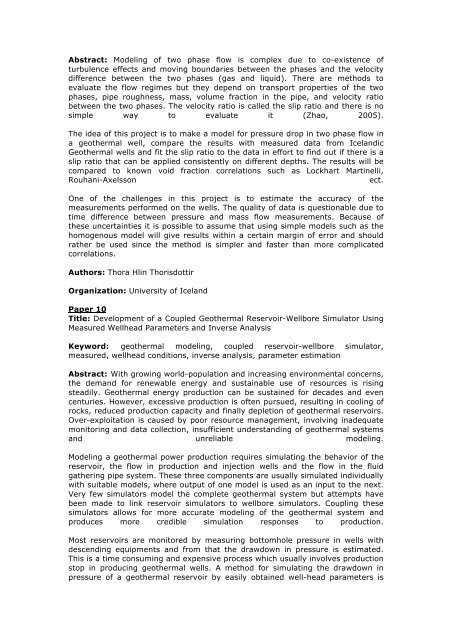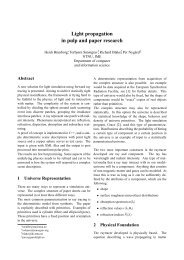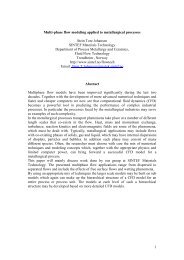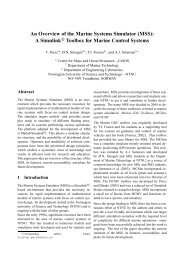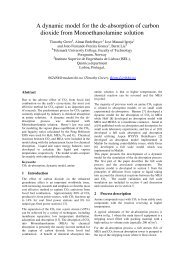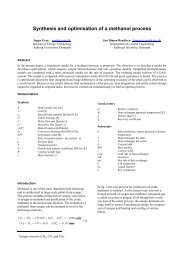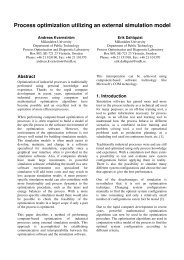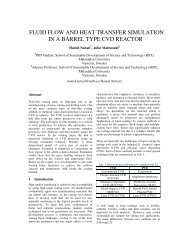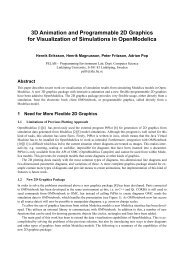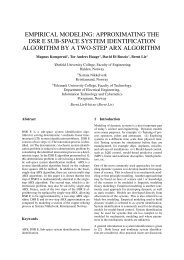detailed programme - SIMS - Scandinavian Simulation Society
detailed programme - SIMS - Scandinavian Simulation Society
detailed programme - SIMS - Scandinavian Simulation Society
Create successful ePaper yourself
Turn your PDF publications into a flip-book with our unique Google optimized e-Paper software.
Abstract: Modeling of two phase flow is complex due to co-existence of<br />
turbulence effects and moving boundaries between the phases and the velocity<br />
difference between the two phases (gas and liquid). There are methods to<br />
evaluate the flow regimes but they depend on transport properties of the two<br />
phases, pipe roughness, mass, volume fraction in the pipe, and velocity ratio<br />
between the two phases. The velocity ratio is called the slip ratio and there is no<br />
simple way to evaluate it (Zhao, 2005).<br />
The idea of this project is to make a model for pressure drop in two phase flow in<br />
a geothermal well, compare the results with measured data from Icelandic<br />
Geothermal wells and fit the slip ratio to the data in effort to find out if there is a<br />
slip ratio that can be applied consistently on different depths. The results will be<br />
compared to known void fraction correlations such as Lockhart Martinelli,<br />
Rouhani-Axelsson<br />
ect.<br />
One of the challenges in this project is to estimate the accuracy of the<br />
measurements performed on the wells. The quality of data is questionable due to<br />
time difference between pressure and mass flow measurements. Because of<br />
these uncertainties it is possible to assume that using simple models such as the<br />
homogenous model will give results within a certain margin of error and should<br />
rather be used since the method is simpler and faster than more complicated<br />
correlations.<br />
Authors: Thora Hlin Thorisdottir<br />
Organization: University of Iceland<br />
Paper 10<br />
Title: Development of a Coupled Geothermal Reservoir-Wellbore Simulator Using<br />
Measured Wellhead Parameters and Inverse Analysis<br />
Keyword: geothermal modeling, coupled reservoir-wellbore simulator,<br />
measured, wellhead conditions, inverse analysis, parameter estimation<br />
Abstract: With growing world-population and increasing environmental concerns,<br />
the demand for renewable energy and sustainable use of resources is rising<br />
steadily. Geothermal energy production can be sustained for decades and even<br />
centuries. However, excessive production is often pursued, resulting in cooling of<br />
rocks, reduced production capacity and finally depletion of geothermal reservoirs.<br />
Over-exploitation is caused by poor resource management, involving inadequate<br />
monitoring and data collection, insufficient understanding of geothermal systems<br />
and unreliable modeling.<br />
Modeling a geothermal power production requires simulating the behavior of the<br />
reservoir, the flow in production and injection wells and the flow in the fluid<br />
gathering pipe system. These three components are usually simulated individually<br />
with suitable models, where output of one model is used as an input to the next.<br />
Very few simulators model the complete geothermal system but attempts have<br />
been made to link reservoir simulators to wellbore simulators. Coupling these<br />
simulators allows for more accurate modeling of the geothermal system and<br />
produces more credible simulation responses to production.<br />
Most reservoirs are monitored by measuring bottomhole pressure in wells with<br />
descending equipments and from that the drawdown in pressure is estimated.<br />
This is a time consuming and expensive process which usually involves production<br />
stop in producing geothermal wells. A method for simulating the drawdown in<br />
pressure of a geothermal reservoir by easily obtained well-head parameters is


